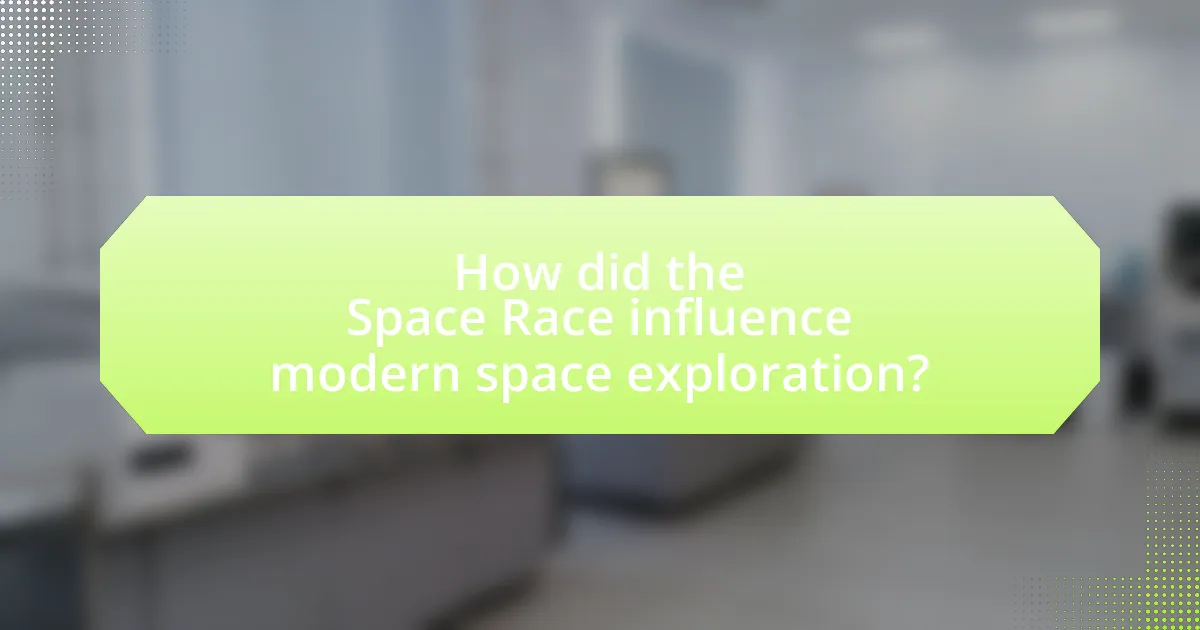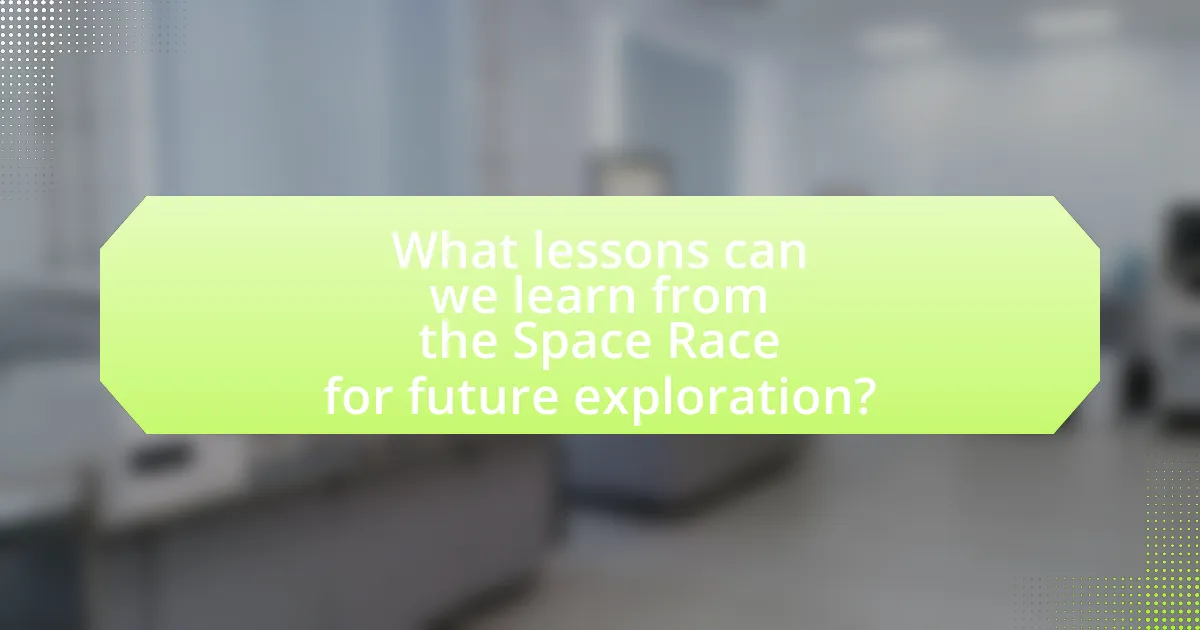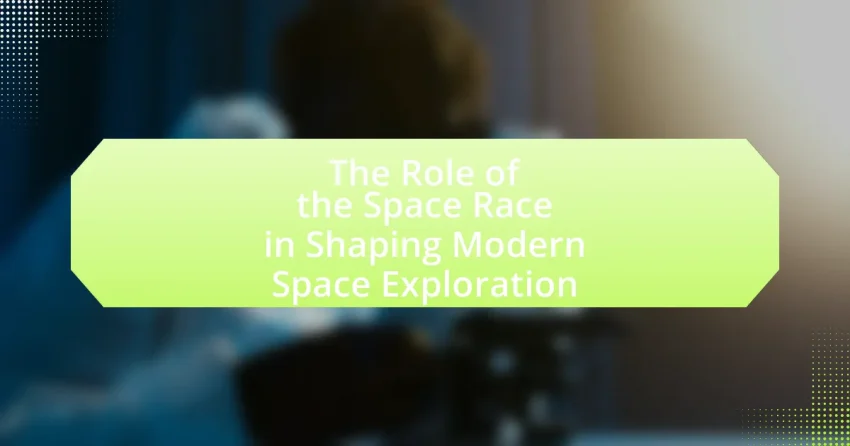The Space Race was a pivotal competition between the United States and the Soviet Union during the Cold War, aimed at achieving significant milestones in space exploration. It began with the launch of Sputnik 1 in 1957 and led to major achievements such as the Apollo 11 Moon landing in 1969. This rivalry not only spurred technological advancements and national pride but also influenced international relations and laid the groundwork for modern space exploration initiatives. The article explores the origins, key events, and implications of the Space Race, highlighting its lasting impact on contemporary space missions, technological innovations, and global collaboration in space exploration.

What was the Space Race and why is it significant?
The Space Race was a competition between the United States and the Soviet Union during the Cold War to achieve significant milestones in space exploration. This rivalry began in the late 1950s, marked by the Soviet Union’s launch of Sputnik 1 in 1957, the first artificial satellite, which prompted the U.S. to accelerate its own space program. The significance of the Space Race lies in its profound impact on technological advancements, national pride, and international relations, culminating in the U.S. landing astronauts on the Moon in 1969 with Apollo 11. This achievement not only demonstrated technological superiority but also inspired future generations and laid the groundwork for ongoing space exploration initiatives, including international cooperation in the International Space Station and Mars exploration missions.
How did the Space Race begin?
The Space Race began in the aftermath of World War II, primarily driven by the geopolitical tensions of the Cold War between the United States and the Soviet Union. The launch of Sputnik 1 by the Soviet Union on October 4, 1957, marked the first artificial satellite to orbit the Earth, igniting fears in the U.S. about Soviet technological superiority. This event prompted the U.S. government to increase funding for space exploration and education, leading to the establishment of NASA in 1958. The competition for dominance in space became a symbol of national pride and technological prowess, influencing subsequent advancements in space exploration.
What were the key events that marked the start of the Space Race?
The key events that marked the start of the Space Race include the launch of Sputnik 1 by the Soviet Union on October 4, 1957, and the subsequent launch of Sputnik 2 on November 3, 1957, which carried the first living creature, a dog named Laika, into space. These events demonstrated the Soviet Union’s advanced capabilities in space technology, prompting the United States to accelerate its own space program, leading to the establishment of NASA in 1958. The successful launch of these satellites signified the beginning of intense competition between the two superpowers in space exploration.
Who were the main players involved in the Space Race?
The main players involved in the Space Race were the United States and the Soviet Union. The competition between these two superpowers was marked by significant events such as the launch of Sputnik 1 by the Soviet Union in 1957, which was the first artificial satellite, and the United States’ Apollo 11 mission in 1969, which successfully landed humans on the Moon. This rivalry not only spurred advancements in technology and space exploration but also had profound implications for international relations during the Cold War era.
What were the major achievements during the Space Race?
The major achievements during the Space Race include the launch of Sputnik 1 by the Soviet Union in 1957, marking the first artificial satellite in orbit. This event initiated the competition between the United States and the Soviet Union for dominance in space exploration. Following this, the United States achieved a significant milestone with the Apollo 11 mission in 1969, successfully landing astronauts Neil Armstrong and Buzz Aldrin on the Moon, making them the first humans to set foot on another celestial body. Additionally, the Soviet Union’s Vostok 1 mission in 1961 successfully sent Yuri Gagarin into space, making him the first human to orbit the Earth. These achievements not only demonstrated technological prowess but also had profound implications for science, technology, and international relations during the Cold War era.
How did the launch of Sputnik influence global perceptions of space exploration?
The launch of Sputnik in 1957 significantly shifted global perceptions of space exploration by demonstrating the technological capabilities of the Soviet Union and igniting a competitive space race with the United States. This event marked the first time a human-made object successfully orbited the Earth, leading to widespread fear and admiration regarding the potential of space technology. The successful launch prompted nations to reassess their own space programs and invest heavily in scientific research and education, as evidenced by the establishment of NASA in response to the perceived threat. Sputnik’s impact was profound, as it not only symbolized a new era of scientific achievement but also influenced public opinion, fostering a sense of urgency and excitement about the possibilities of space exploration.
What were the implications of the Apollo Moon landing?
The implications of the Apollo Moon landing were profound, significantly advancing space exploration, technology, and international relations. The successful landing of Apollo 11 on July 20, 1969, demonstrated the United States’ technological superiority during the Cold War, effectively shifting the balance in the Space Race against the Soviet Union. This achievement led to increased funding and interest in science and technology education, fostering innovation in various fields, including telecommunications, materials science, and computer technology. Additionally, the Apollo program inspired global cooperation in space exploration, laying the groundwork for future international missions, such as the International Space Station, which began in the 1990s. The Moon landing also had lasting cultural impacts, influencing art, literature, and public perception of space travel, ultimately shaping humanity’s vision of its place in the universe.

How did the Space Race influence modern space exploration?
The Space Race significantly influenced modern space exploration by establishing foundational technologies, fostering international collaboration, and igniting public interest in space. The competition between the United States and the Soviet Union led to rapid advancements in rocket technology, satellite communications, and human spaceflight, exemplified by milestones such as the launch of Sputnik in 1957 and the Apollo Moon landing in 1969. These achievements not only demonstrated the feasibility of space exploration but also prompted governments and private entities to invest in space programs, resulting in the establishment of organizations like NASA and ESA. Furthermore, the legacy of the Space Race continues to shape current international partnerships, such as the International Space Station, and inspires ongoing missions to Mars and beyond, highlighting the enduring impact of this historical period on contemporary space endeavors.
What technological advancements emerged from the Space Race?
The Space Race led to significant technological advancements, including satellite technology, advancements in rocketry, and developments in computer technology. Satellite technology emerged with the launch of Sputnik 1 by the Soviet Union in 1957, marking the beginning of space-based communication and Earth observation. Advancements in rocketry were exemplified by the development of the Saturn V rocket, which enabled human spaceflight to the Moon during the Apollo missions. Additionally, the Space Race spurred innovations in computer technology, such as the development of integrated circuits and early computing systems, which were crucial for navigation and control in space missions. These advancements laid the groundwork for modern space exploration and various technologies used today.
How did these advancements shape current space missions?
Advancements from the Space Race significantly shaped current space missions by establishing foundational technologies and fostering international collaboration. The development of satellite technology, exemplified by the launch of Sputnik in 1957, enabled global communication and Earth observation, which are critical for modern missions. Additionally, advancements in rocket propulsion and navigation systems, driven by competition between the U.S. and the Soviet Union, laid the groundwork for reliable launch vehicles used today, such as SpaceX’s Falcon 9 and NASA’s Space Launch System. Furthermore, the emphasis on scientific research during the Space Race led to the establishment of international partnerships, as seen in the International Space Station, which promotes shared knowledge and resources among nations. These historical advancements continue to influence mission planning, technology development, and international cooperation in contemporary space exploration.
What role did international collaboration play in post-Space Race exploration?
International collaboration significantly advanced post-Space Race exploration by fostering shared resources, knowledge, and technology among nations. For instance, the establishment of the International Space Station (ISS) in 1998 exemplifies this collaboration, involving space agencies from the United States, Russia, Europe, Japan, and Canada, which collectively contribute to scientific research and technological development. This partnership has enabled diverse scientific experiments in microgravity, enhancing our understanding of space and its effects on human health. Additionally, collaborative missions, such as the Mars rover projects, have allowed for pooling expertise and funding, leading to more ambitious exploration goals. Thus, international collaboration has been crucial in expanding the scope and capabilities of space exploration beyond what individual nations could achieve alone.
How did the Space Race impact public interest in space exploration?
The Space Race significantly heightened public interest in space exploration by fostering a sense of national pride and technological achievement. This period, particularly from the late 1950s to the early 1970s, saw major milestones such as the launch of Sputnik by the Soviet Union in 1957 and the Apollo 11 moon landing in 1969, which captivated global audiences. Public engagement surged as media coverage expanded, with millions watching live broadcasts of space missions, thereby transforming space exploration into a topic of widespread fascination and discussion. The U.S. government also invested heavily in education and outreach programs, further stimulating interest in science and technology among the general populace.
What cultural shifts occurred as a result of the Space Race?
The Space Race led to significant cultural shifts, including increased public interest in science and technology, a surge in educational initiatives focused on STEM (science, technology, engineering, and mathematics), and the emergence of a space-oriented popular culture. The launch of Sputnik by the Soviet Union in 1957 ignited fears of falling behind in technological advancement, prompting the United States to invest heavily in education and research, exemplified by the National Defense Education Act of 1958. This act aimed to enhance the nation’s scientific capabilities and produced a generation of scientists and engineers. Additionally, the Space Race influenced media and entertainment, with films, books, and television shows reflecting themes of space exploration, such as “Star Trek,” which debuted in 1966 and promoted a vision of a future where humanity explores the cosmos. These cultural shifts not only transformed public perception of science but also laid the groundwork for ongoing interest and investment in space exploration.
How did education and funding for STEM fields change due to the Space Race?
The Space Race significantly increased education and funding for STEM fields. In response to the launch of Sputnik by the Soviet Union in 1957, the United States government prioritized science and technology education, leading to the establishment of initiatives like the National Defense Education Act of 1958, which allocated federal funds to improve STEM education in schools and universities. This act resulted in a dramatic rise in enrollment in engineering and science programs, with the number of degrees awarded in these fields doubling by the mid-1960s. Additionally, federal funding for research and development in STEM areas surged, with NASA’s budget increasing from $89 million in 1958 to over $5 billion by 1966, reflecting the urgent need for advancements in technology and engineering to compete in the Space Race.

What lessons can we learn from the Space Race for future exploration?
The Space Race teaches us the importance of international collaboration, technological innovation, and the need for clear objectives in future exploration. The competition between the United States and the Soviet Union led to significant advancements in technology, such as satellite communication and human spaceflight, exemplified by the launch of Sputnik in 1957 and the Apollo 11 moon landing in 1969. These milestones demonstrate that focused investment in research and development can yield transformative results. Additionally, the Space Race highlighted the necessity of global partnerships, as seen in the International Space Station, which fosters cooperation among nations for shared scientific goals.
How can the competitive spirit of the Space Race be applied today?
The competitive spirit of the Space Race can be applied today by fostering innovation and collaboration in space exploration among nations and private entities. This competitive drive encourages advancements in technology, as seen in the rapid development of reusable rocket systems by companies like SpaceX, which has reduced launch costs significantly. Additionally, international partnerships, such as the Artemis program involving NASA and international space agencies, exemplify how competition can lead to collaborative efforts that push the boundaries of human exploration beyond Earth. The historical context of the Space Race demonstrates that competition can accelerate progress, as evidenced by the technological breakthroughs achieved during that era, including satellite technology and advancements in materials science.
What are the potential benefits of renewed competition in space exploration?
Renewed competition in space exploration can lead to accelerated technological advancements. Historical evidence shows that the original Space Race between the United States and the Soviet Union resulted in significant innovations, such as satellite technology and advancements in materials science. Increased competition encourages private sector involvement, as seen with companies like SpaceX and Blue Origin, which have driven down launch costs and increased access to space. Furthermore, competition fosters collaboration among nations, as countries may seek partnerships to share resources and expertise, enhancing global scientific knowledge and capabilities.
How can collaboration between nations enhance future space missions?
Collaboration between nations can enhance future space missions by pooling resources, expertise, and technology, leading to more ambitious and cost-effective projects. For instance, the International Space Station (ISS) exemplifies successful international cooperation, involving space agencies from the United States, Russia, Europe, Japan, and Canada, which has resulted in shared scientific research and technological advancements. Additionally, collaborative efforts can facilitate the sharing of data and best practices, as seen in the joint missions like the Mars Exploration Program, where multiple countries contribute to a unified goal of exploring Mars. This synergy not only accelerates innovation but also reduces the financial burden on individual nations, making space exploration more sustainable and inclusive.
What are the current challenges in space exploration that echo the Space Race?
Current challenges in space exploration that echo the Space Race include geopolitical competition, technological innovation demands, and funding constraints. Geopolitical competition is evident as nations like the United States and China strive for dominance in space, reminiscent of the U.S.-Soviet rivalry during the Space Race. Technological innovation demands are highlighted by the need for advanced spacecraft and sustainable life support systems, similar to the rapid advancements made in the 1960s. Funding constraints persist as governments and private entities navigate budget limitations while aiming for ambitious missions, paralleling the financial pressures faced during the original Space Race. These challenges reflect the ongoing urgency and competitive spirit that characterized the historical context of space exploration.
How can we address funding and resource allocation for future missions?
To address funding and resource allocation for future missions, governments and private entities must prioritize collaborative partnerships and innovative funding models. Historical examples, such as NASA’s partnerships with private companies like SpaceX, demonstrate that leveraging private investment can significantly reduce costs and enhance mission capabilities. Additionally, reallocating existing budgets towards high-impact projects, as seen in the increased funding for Artemis missions, can ensure that resources are effectively utilized for future exploration goals.
What strategies can be implemented to inspire the next generation of explorers?
To inspire the next generation of explorers, educational programs that emphasize STEM (Science, Technology, Engineering, and Mathematics) and hands-on experiences in exploration-related fields should be implemented. These programs can include interactive workshops, field trips to science centers, and partnerships with organizations involved in space exploration, such as NASA. Research indicates that early exposure to STEM activities significantly increases interest in these fields; for instance, a study by the National Science Foundation found that students engaged in hands-on science activities are more likely to pursue STEM careers. Additionally, mentorship programs connecting young individuals with professionals in exploration can provide guidance and inspiration, fostering a sense of possibility and ambition.
What practical steps can be taken to foster innovation in space exploration?
To foster innovation in space exploration, governments and private sectors should increase funding for research and development in aerospace technologies. Increased investment has historically led to breakthroughs, as seen during the Apollo program, which received significant funding that resulted in advancements in materials science and propulsion systems. Collaborative partnerships between public agencies like NASA and private companies such as SpaceX can also drive innovation by combining resources and expertise, exemplified by NASA’s Commercial Crew Program, which has successfully enabled private spacecraft to transport astronauts to the International Space Station. Additionally, creating regulatory frameworks that encourage experimentation and reduce bureaucratic hurdles can facilitate rapid prototyping and testing of new technologies, similar to the agile methodologies adopted in the tech industry.
